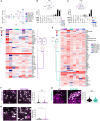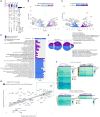Transcriptional modulation unique to vulnerable motor neurons predicts ALS across species and SOD1 mutations
- PMID: 40675818
- PMCID: PMC12400948
- DOI: 10.1101/gr.279501.124
Transcriptional modulation unique to vulnerable motor neurons predicts ALS across species and SOD1 mutations
Abstract
Amyotrophic lateral sclerosis (ALS) is characterized by the progressive loss of motor neurons (MNs) that innervate skeletal muscles. However, certain MN groups including ocular MNs, are relatively resilient. To reveal key drivers of resilience versus vulnerability in ALS, we investigate the transcriptional dynamics of four distinct MN populations in SOD1G93A ALS mice using LCM-seq and single-molecule fluorescent in situ hybridization. We find that resilient ocular MNs regulate few genes in response to disease. Instead, they exhibit high baseline gene expression of neuroprotective factors, including En1, Pvalb, Cd63, and Gal, some of which vulnerable MNs upregulate during disease. Vulnerable MN groups upregulate both detrimental and regenerative responses to ALS and share pathway activation, indicating that breakdown occurs through similar mechanisms across vulnerable neurons, albeit with distinct timing. Meta-analysis across four rodent mutant Sod1 MN transcriptome data sets identify a shared vulnerability code of 39 genes, including Atf4, Nupr1, Ddit3, and Penk, involved in apoptosis, as well as a proregenerative and antiapoptotic signature consisting of Atf3, Vgf, Ina, Sprr1a, Fgf21, Gap43, Adcyap1, and Mt1 Machine learning using genes upregulated in SOD1G93A spinal MN predicts disease in human stem cell-derived SOD1E100G MNs and shows that dysregulation of VGF, INA, and PENK is a strong disease predictor across species and SOD1 mutations. Our study reveals MN population-specific gene expression and temporal disease-induced regulation that together provide a basis to explain ALS selective vulnerability and resilience and that can be used to predict disease.
© 2025 Mei et al.; Published by Cold Spring Harbor Laboratory Press.
Figures






References
-
- An D, Fujiki R, Iannitelli DE, Smerdon JW, Maity S, Rose MF, Gelber A, Wanaselja EK, Yagudayeva I, Lee JY, et al. 2019. Stem cell-derived cranial and spinal motor neurons reveal proteostatic differences between ALS resistant and sensitive motor neurons. eLife 8: e44423. 10.7554/eLife.44423 - DOI - PMC - PubMed
MeSH terms
Substances
LinkOut - more resources
Full Text Sources
Medical
Research Materials
Miscellaneous
